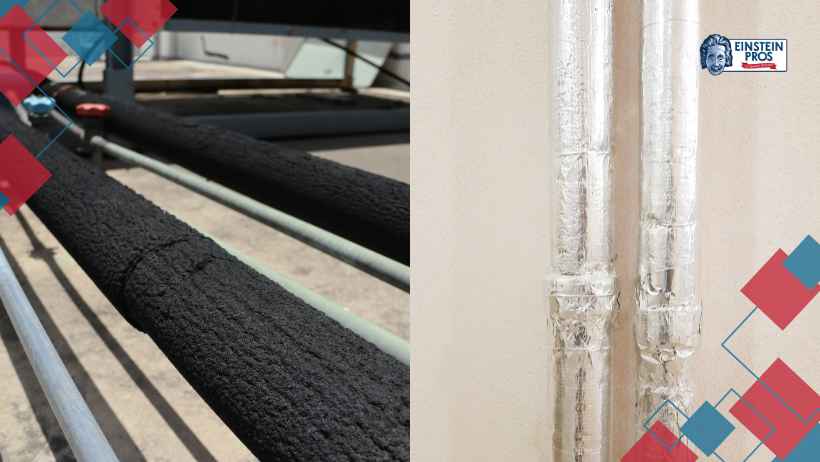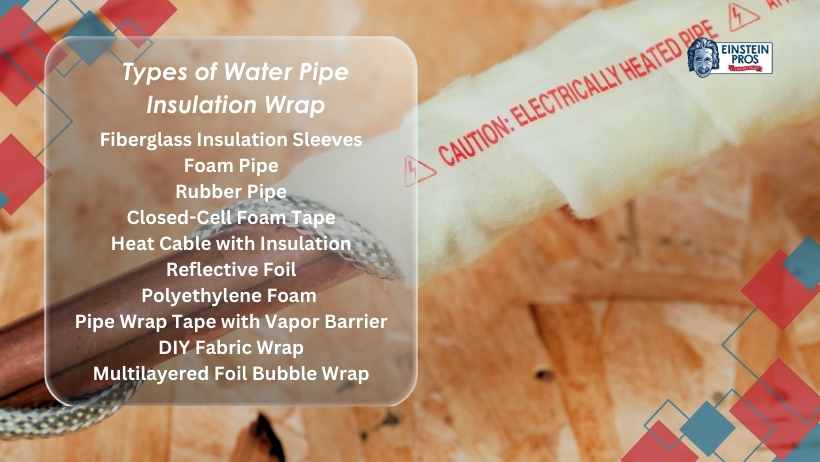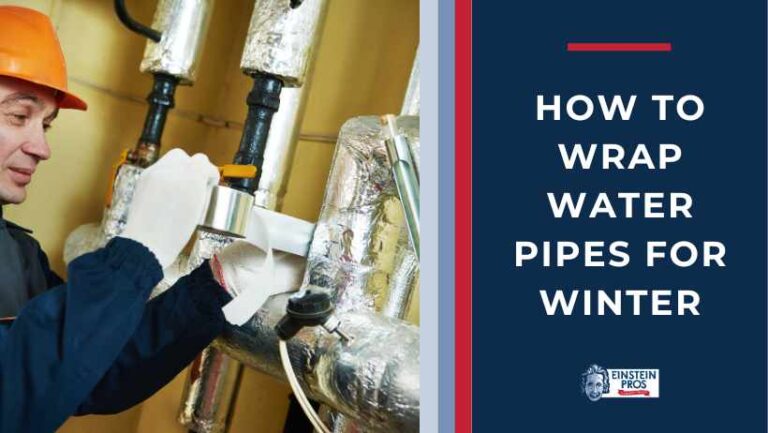One critical aspect of winterizing your home is protecting your water pipes from freezing temperatures. A burst pipe can lead to costly damage and inconvenience. In this guide, we will delve into the importance of wrapping water pipes and provide a step-by-step on how to wrap water pipes for winter so they remain intact and functional throughout the cold season.
What is A Water Pipe Wrap?
A water pipe wrap is a protective insulation material designed to shield water pipes from the detrimental effects of freezing temperatures. This crucial retains heat, thereby maintaining the water within the pipes at a temperature above freezing. The primary purpose of a water pipe wrap is to provide a barrier that wraps:
- Material Composition: Water pipe wraps are typically made from insulating materials such as foam, rubber, fiberglass, or other thermal-resistant substances. These materials are chosen for their ability to trap heat and create a barrier against the cold, ensuring that your water pipe insulation is a success.
- Pre-formed Sleeves or Tape: Water pipe wraps come in various forms, including pre-formed sleeves and tape. Pre-formed sleeves, also known as insulation sleeves, are cylindrical tubes that fit snugly around the pipe. Pipe wrap tape, on the other hand, is a flexible material that can be wound around the pipe to provide insulation.
- Ease of Installation: One of the advantages of water pipe wraps is their ease of installation. Homeowners can easily apply them without the need for specialized tools. The simplicity of installation makes it a practical solution for individuals looking to winterize their plumbing systems independently.
- Protection Against Freezing: The primary function of a water pipe wrap is to protect pipes from freezing. When applied correctly, the insulation layer created by the wrap helps maintain a stable temperature within the pipes, preventing the formation of ice that could lead to pipe damage.
- Versatility in Sizing: Water pipe wraps are available in various sizes to accommodate different pipe diameters. This versatility ensures that homeowners can select the appropriate wrap size for their specific plumbing system, providing a customized fit for optimal insulation.
- Compatibility with Other Methods: Water pipe wraps can be used in conjunction with other winterization methods, such as heat cables or space heaters. Combining these approaches enhances overall protection against freezing, especially in extremely cold climates.
- Moisture Resistance: High-quality water pipe wraps exhibit moisture-resistant properties. This feature is crucial as it prevents the insulation material from absorbing water, ensuring the effectiveness of the wrap even in damp conditions.
- Durability and Longevity: A well-installed water pipe wrap is durable and can withstand seasonal temperature variations. The longevity of the insulation contributes to its effectiveness over multiple winter seasons, providing ongoing protection for the plumbing system.
- Affordability: Water pipe wraps are a cost-effective solution for winterizing pipes when compared to potential repair or replacement costs resulting from frozen or burst pipes. Their affordability makes them a practical choice for homeowners seeking a budget-friendly way to safeguard their plumbing.
Factors to Consider When Wrapping Water Pipes
1. Understanding the Risks of Frozen Pipes
Winter brings freezing temperatures, and when water inside pipes freezes, it expands, putting immense pressure on the pipe walls. This pressure can cause pipes to crack or burst, leading to water damage and potential structural issues in your home. Wrapping your water pipes is a proactive measure to prevent such disasters.
Assessing Vulnerable Areas
- Identify areas in your home where pipes are most exposed to cold temperatures. Exterior walls, unheated basements, and crawl spaces are common culprits. Conduct a thorough inspection to pinpoint vulnerable sections that require extra attention during the wrapping process.
Recognizing the Signs of Frozen Pipes
- Educate yourself on the signs of frozen pipes to catch potential issues early. Reduced water flow, strange odors, and unusual sounds from the pipes are indicators of a problem. If you notice any of these signs, taking immediate action can prevent further damage.
2. Selecting the Right Materials for Wrapping
Choosing the appropriate materials for wrapping your water pipes is crucial for effective insulation. Several options are available, each with its own set of advantages. Consider factors such as the climate in your region and the specific needs of your plumbing system.
Insulation Sleeves
- Insulation sleeves, also known as pipe sleeves or pipe wrap, are commonly used to protect pipes from freezing. These pre-formed foam tubes are easy to install and provide excellent insulation. Measure the diameter and length of your pipes to ensure a snug fit when selecting insulation sleeves.

Pipe Wrap Tape
- Pipe wrap tape is a versatile option for insulating pipes. It is typically made of materials like fiberglass or rubber and can be wrapped tightly around pipes of various sizes. Ensure the tape is moisture-resistant and has a high insulating value to effectively protect against the cold. Given Seattle’s reputation for frequent rainfall and high humidity levels, insulated pipes in Seattle are designed to be highly resistant to moisture. This feature is crucial to prevent the insulation material from becoming compromised, maintaining its effectiveness over time.
Heat Cable
- For extremely cold climates like Seattle, Washington, consider using heat cables in addition to insulation. This cable can be wrapped around pipes to provide a constant source of heat, preventing freezing. Use it in conjunction with insulation for comprehensive protection.
3. Preparing Your Pipes for Wrapping
Before you begin wrapping your water pipes, it’s essential to prepare them properly. This involves cleaning and, if necessary, repairing any existing damage to ensure a secure and effective insulation layer.
Cleaning the Pipes
- Clean the pipes thoroughly to remove any dirt, dust, or grease that may interfere with the adhesion of insulation materials. Use a mild cleaning solution and a cloth to wipe down the surface of the pipes.
Repairing Leaks and Cracks
- Inspect your pipes for any existing leaks or cracks. Addressing leaking pipes before wrapping the pipes is crucial, as insulation alone may not be sufficient to prevent further damage. Use appropriate sealants or pipe repair kits to fix any vulnerabilities.
4. Proper Techniques for Wrapping Water Pipes
The way you wrap your pipes significantly influences the effectiveness of the insulation. Follow these techniques to ensure a secure and durable wrapping job.
Begin at the Pipe’s Origin
- Start wrapping the pipes from their origin point, typically where they enter your home. This ensures that the entire length of the pipe is adequately insulated, leaving no vulnerable sections exposed to the cold.
Overlapping Insulation Material
- Whether you’re using insulation sleeves, pipe wrap tape, or a combination of both, ensure that each layer overlaps slightly. This prevents gaps and ensures uniform insulation, reducing the risk of cold spots where freezing may occur.
Secure with Adhesive or Fasteners
- Use adhesive or fasteners to secure the insulation in place. This step is crucial, especially in areas with high humidity or temperature fluctuations. Properly secured insulation remains effective over time, providing long-term protection.
5. Paying Attention to Specific Areas
Certain areas of your plumbing system require special consideration during the wrapping process. Addressing these specific points will enhance the overall effectiveness of your winterization efforts.
Insulating Exposed Outdoor Pipes
- Outdoor pipes, such as hose bibs and sprinkler system lines, are particularly susceptible to freezing. Disconnect and drain these lines before wrapping them with insulation. Additionally, consider using insulated covers for added protection.
Protecting Interior Pipes in Unheated Spaces
- Unheated spaces, such as crawl spaces and basements, pose a significant risk to your pipes. Insulate pipes in these areas thoroughly and consider using space heaters or other heating solutions to maintain a minimum temperature.
6. Monitoring and Maintenance
Winterizing your water pipes is not a one-time task; it requires ongoing monitoring and maintenance to ensure continued effectiveness. Stay vigilant throughout the winter months and take prompt action if any issues arise.
Regularly Check for Signs of Freezing
- Periodically check for signs of freezing, even after wrapping your pipes. If you notice reduced water flow, strange odors, or unusual sounds, investigate the cause promptly. Early detection allows for timely intervention and prevents extensive damage.
Adjusting Insulation as Needed
- As winter progresses, assess the condition of the insulation on your pipes. Extreme weather conditions or unforeseen circumstances may necessitate adjustments. Add additional layers or replace damaged insulation to maintain optimal protection.
7. Additional Tips for Winter Pipe Protection
In addition to wrapping your water pipes, consider implementing these extra tips to enhance the overall winter protection of your plumbing system.
Keep Interior Doors Open
- Maintain a consistent temperature throughout your home by keeping interior doors open. This allows warm air to circulate freely, reaching all areas, including those with exposed pipes.
Allowing Faucets to Drip
- In extremely cold weather, allowing faucets to drip slightly can prevent pipes from freezing. The continuous flow of water reduces the risk of ice buildup inside the pipes.
Winterizing Vacant Properties
- If you plan to leave your home vacant during the winter, take additional precautions. Shut off the main water supply, drain the plumbing system, and consider using antifreeze solutions in toilets and drains.
8. Ensuring Adequate Insulation Thickness
While wrapping your pipes, pay attention to the thickness of the insulation. In frigid climates, thicker insulation provides an additional layer of protection against freezing temperatures. Ensure that the insulation thickness meets or exceeds the recommended standards for your region.
Assessing Local Climate Requirements
- Research the specific insulation thickness recommended for your local climate. Different regions have varying temperature ranges, and adapting your insulation thickness accordingly ensures optimal protection against freezing. Seattle experiences mild winter temperatures, with occasional drops below freezing. Insulated pipes act as a barrier against these colder temperatures, ensuring that the water within the pipes remains at a consistent temperature to prevent freezing and potential pipe damage. Make sure to contact a licensed plumber in Seattle to help you with your pipe insulation needs.
Professional Consultation for Complex Systems
- For complex plumbing systems or homes with unique structural considerations, seek professional consultation from Einstein Pros. Plumbers and insulation specialists can assess your specific situation and provide tailored recommendations for achieving the ideal insulation thickness.
Consideration for Wind Chill
- Factor in wind chill when determining the appropriate insulation thickness. Wind can significantly lower the effective temperature, increasing the risk of frozen pipes. Some frozen pipe prevention tips in Seattle include using thicker insulation to help counteract the impact of wind chill.
How to Choose the Best Water Pipe Insulation Wrap
Selecting the best water pipe insulation wrap involves considering various factors, including the specific needs of your plumbing system, the climate in your region, and the insulation material’s effectiveness. Here are some recommendations for water pipe insulation wraps:

Fiberglass Insulation Sleeves:
- Advantages:
- Excellent Thermal Insulation: Fiberglass insulation sleeves are known for their high thermal resistance, effectively preventing heat loss and protecting pipes from freezing.
- Moisture Resistance: Fiberglass is inherently resistant to moisture, reducing the risk of mold and mildew growth, which can compromise insulation efficiency.
- Easy Installation: These sleeves are pre-formed, making them easy to install with minimal effort and no need for additional tools.
- Considerations:
- Sealing Requirements: While fiberglass is moisture-resistant, ensuring proper sealing at the joints is essential to prevent any potential moisture ingress.
Foam Pipe Insulation:
- Advantages:
- Flexibility and Lightweight: Foam pipe insulation is lightweight and flexible, facilitating easy installation and allowing for a secure fit around various pipe shapes.
- Thermal Insulation: This material provides good thermal insulation, reducing heat transfer and maintaining consistent temperatures within the pipes.
- Moisture Resistance: Like fiberglass, foam is resistant to moisture, minimizing the risk of mold or mildew formation.
- Considerations:
- Secure Fit: To ensure optimal insulation, attention must be given to achieving a secure fit, especially in regions with extremely cold temperatures.
Rubber Pipe Insulation:
- Advantages:
- Flexibility: Rubber insulation offers excellent flexibility, making it easy to wrap around pipes and ensuring a snug fit.
- Thermal Properties: Rubber provides effective thermal insulation, helping to maintain a stable temperature within the pipes.
- Moisture and UV Resistance: Resistant to both moisture and UV exposure, rubber insulation is suitable for a range of environments.
- Considerations:
- UV-Resistant Options: When using rubber insulation outdoors, it’s advisable to select UV-resistant variants to prevent degradation over time.
Closed-Cell Foam Tape:
- Advantages:
- Adhesive-backed for Easy Application: Closed-cell foam tape comes with adhesive backing, simplifying the installation process and ensuring a secure attachment to the pipes.
- Ideal for Irregular Shapes: Suitable for irregularly shaped pipes or areas where pre-formed sleeves may be challenging to apply.
- Moisture Resistance and Durability: Exhibits moisture resistance and durability, providing reliable long-term insulation.
- Considerations:
- Adhesive Effectiveness: Confirm the adhesive’s effectiveness, especially in varying temperatures, to prevent any potential detachment.
Heat Cable with Insulation:
- Advantages:
- Active Heating: Heat cables actively provide warmth to the pipes, preventing freezing in extremely cold climates and offering an additional layer of protection.
- Compatibility with Other Insulation: Can be used in combination with other insulation materials for comprehensive winterization.
- Considerations:
- Electrical Access: Requires access to electricity, making it essential to install near power sources or outlets.
Reflective Foil Insulation:
- Advantages:
- Radiant Heat Reflection: Reflective foil insulation works by reflecting radiant heat, enhancing overall insulation effectiveness.
- Lightweight and Space-efficient: Lightweight and suitable for areas with limited space, making it a versatile choice for different pipe configurations.
- Suitable for Complementary Use: Ideal for use in conjunction with other insulation materials to maximize protection.
- Considerations:
- Complementary Use: While effective, reflective foil insulation often works best when used alongside other insulation methods for comprehensive coverage.
How to Wrap Water Pipes for Winter with Polyethylene Foam:
- Advantages:
- Closed-Cell Structure: The closed-cell structure provides effective thermal insulation, reducing heat transfer and preventing freezing.
- Resistance to Moisture and Chemicals: Resistant to moisture and chemicals, ensuring durability and longevity.
- Customization: Easy to cut and customize for a snug fit around various pipe sizes and configurations.
- Considerations:
- Fire-Resistant Options: For added safety, especially in residential settings, consider polyethylene foam pipe insulation with fire-resistant properties.
Pipe Wrap Tape with Vapor Barrier:
- Advantages:
- Combined Insulation and Vapor Barrier: Provides both insulation and a vapor barrier, preventing moisture ingress and ensuring effective insulation.
- Adhesive-backed for Easy Application: Adhesive backing simplifies the application process, ensuring a secure attachment to the pipes.
- Suitable for Humid Environments: Particularly suitable for use in areas with high humidity levels.
- Considerations:
- Compatibility with Pipe Materials: Confirm compatibility with different pipe materials to prevent any adverse reactions.
DIY Fabric Insulation Wrap:
- Advantages:
- Custom Fit: Allows for a custom, snug fit around pipes, addressing irregular shapes or challenging configurations.
- Securable with Fasteners: This can be secured with fasteners, enhancing durability and preventing any potential displacement.
- Suitable for Irregular Pipes: Ideal for insulating irregularly shaped pipes that may be challenging for pre-formed sleeves.
- Considerations:
- Careful Installation: Requires careful installation to eliminate gaps and ensure optimal insulation effectiveness.
Multilayered Foil Bubble Wrap:
- Advantages:
- Combined Materials for Enhanced Insulation: Combines foil, bubble wrap, and additional layers for enhanced insulation effectiveness.
- Reflects Radiant Heat: Reflects radiant heat, providing an additional layer of protection against heat loss.
- Versatile for Various Pipe Sizes: Suitable for various pipe sizes, offering versatility in application.
- Considerations:
- Supplementary Use: While effective on its own, multilayered foil bubble wrap can be further strengthened when used with other insulation materials.
When selecting the best water pipe insulation wrap, consider the unique requirements of your plumbing system. Additionally, always adhere to manufacturer guidelines for proper installation and follow local building codes to ensure safety and effectiveness.
Conclusion
Wrapping water pipes for winter is a proactive and essential measure to protect your home from the damaging effects of frozen pipes. By understanding the risks, selecting the right materials, and following proper techniques, you can ensure your plumbing system remains functional and intact throughout the colder months. Regular monitoring, additional protective measures, consulting with the expert plumbers at Einstein Pros, and attention to insulation thickness further contribute to a comprehensive winterization strategy. Don’t wait until the first freeze—take action now to safeguard your pipes and enjoy a worry-free winter season.
